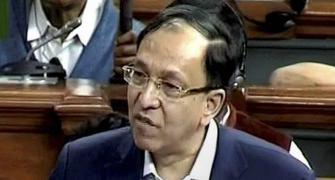'While China has been hiking its defence spending, India has done precious little in implementing the Manmohan Singh government's decision of raising a 90,000-strong China-centric Mountain Strike Corps,' says Rajeev Sharma.

China's defence budget this year has been pegged at $146 billion, though some reports say it has crossed $150 billion for the first time ever.
In any case, either figure is four times than India's current defence budget.
This is definitely a cause to worry for India. Don't forget the fact that in the aftermath of the nuclear tests of 1998, then defence minister George Fernandes named China as India's number one potential security threat.
Well, these are just figures. These relate to the defence budgets of the two countries in question. But when you talk of defence spendings by the two countries concerned, the figure is much more substantive in both cases as both countries tend to show their actual defence spending in other accounts.
But be that as it may, the basic equation remains unchanged in any circumstance. The fact is that China has been pumping much more money into defence than India for well over a decade.
The rate at which Chinese defence spending has been increasing can be gauged from the fact that China has quadrupled its allocations under this subject in the past decade as per official Chinese statistics though the fear is that China may have pumped much more into the defence sector all these years than it has shown in the books.
For example, China spent $216 billion on defence in 2014, according to the Stockholm International Peace Research Institute, though it's official figures under this head showed only $132 billion.
Going by this, one can well understand what the actual Chinese defence spending may be currently.

China's military's expenditures and cash flows are seldom effectively audited and the expenses under this head are controlled internally by the Central Military Commission without any transparency on the exact processes followed.
In theory, China's defence policy is supervised by the National People's Congress or its parliament, the actual figures under the defence spending head are misleading and far under-stated.
China's defence spending has traditionally been an opaque process.
China-watchers worldwide have been spooked by the People's Liberation Army's role and influence. There have been conflicting reports and surmises whether the PLA is more powerful in China than the Chinese government.
One such incident came to the fore when PLA troops had ingressed into Ladakh when Chinese President Xi Jinping was in India (September 2014) and instead of vacating its occupation of Indian territory the PLA actually bolstered its presence on Indian soil in terms of manpower and arsenal.
I was told by several Indian China-watchers that the Chinese president was livid over the PLA's conduct. Xi told Prime Minister Narendra Modi that he had ordered the PLA to vacate its occupation of the territory, which is under Indian control.
Yet, it took several weeks for the PLA to do so and the Chinese occupation of Indian territory was vacated only a couple of weeks after Xi left New Delhi.
This incident underlined potential fissures between the Chinese government and the PLA. Though the PLA has not repeated this since then, doubts about the perceived chasm between the Chinese Communist Party and the PLA persist.
It is against this backdrop that the reports of China's defence budget crossing the $150 billion threshold for the first time should be a matter of grave concern for India.
Add to this the fact that while China has been hiking its defence spending in the name of tensions in the South China Sea, India has done precious little in implementing the Manmohan Singh government's decision of raising a 90,000-strong China-centric Mountain Strike Corps at a cost of $10 billion. The earliest this corps can be operational is by 2021, according to army chief General Dalbir Singh.
The least the government can do is to share with the nation what steps it has taken so far in tackling the Chinese military threat.
Rajeev Sharma is an independent journalist and a strategic analyst who tweets @Kishkindha









